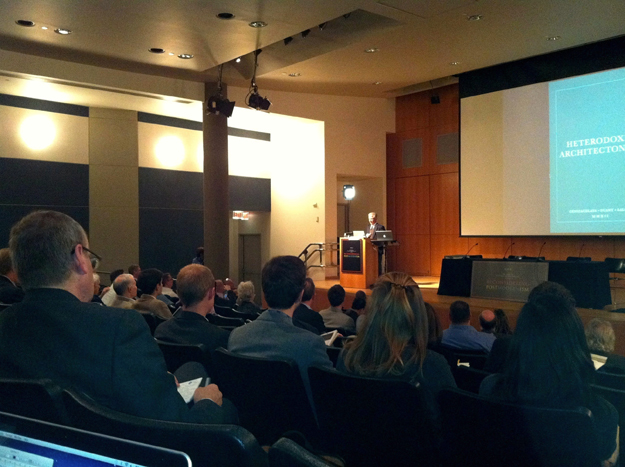An aesthetic that mined the past gets a historical consideration of its own at a New York City symposium.
 |
| Photo ' Alexander Gorlin |
Architect Alexander Gorlin snapped this photo of Columbia University Graduate School of Architecture dean Mark Wigley (left, foreground) watching New Urbanism impresario Andrés Duany speak at the two-day conference. |
“Postmodernism” entered the architectural discourse 36 years ago—in an essay by the British polymath Charles Jencks. Lately, Jencks said, he has been enjoying a holiday from the term he introduced. “I was sick and tired of it.” But his vacation has been interrupted by a spate of retrospectives, including an exhibition at London’s Victoria and Albert Museum and the Reconsidering Postmodernism conference held in Manhattan last week.
The New York event brought Jencks together with other distinguished designers, critics, and historians for a two-day symposium hosted by the Institute of Classical Architecture and Art at the City University of New York’s Graduate Center. Attempting to present a historical look at the notoriously slippery term, the program included discussions of postmoderinism’s influence on everything from urbanism and the media to education and craft.
Sharing the stage with Michael Graves and other veterans of the “whites versus grays” battles of the 1970s and ‘80s, Robert A.M. Stern compared the gathering to a “Golden Girls” reunion. His view was reinforced by the organizers’ choice of Tom Wolfe as the keynote speaker. The 80-year-old author marked the 30th anniversary of “From Bauhaus to Our House” with a rehash of the book’s anti-Modernist screed. He warned the audiences about architects who claim their new buildings are in dialogue with the existing urban fabric. “When you hear the word ‘dialogue,’ think ‘clash,’” said Wolfe.
Indeed, much of what could have been a defense of postmodernism was more of an attack on the current architectural scene. “Everyone wants to do their own thing. But you can’t have Rem Koolhaas making a city,” said Graves. For that reason, the most convincing arguments for postmodernism were made not by its partisans, but by the conference referees, including the New Yorker’sPaul Goldberger, who said that postmodernism, to its credit, “made it possible, even desirable, to engage with buildings emotionally.” He later noted that the rejection of anti-urbanist city planning associated with Modernism is an important, and continuing, legacy of the postmodern movement.
But in two days of discussion, the panelists never quite defined postmodernism. Was it a style, which flourished for five or 10 or 15 years (depending on the speaker), or is it a condition—meaning that, as MoMA’s Barry Bergdoll suggested, we are all postmodernists today? And are classical architects, doing their best to follow millennia-old building traditions really post-anything? Lumping the classicists together with Robert Venturi—whose use of columns and architraves, even its supporters concede, can be superficial and ironic—seems a disservice to both.
Yet several speakers claimed that postmodernism made it possible for classical architecture to flourish in the United States and England. “Postmodernism allowed for that opening; you have to be thankful for that,” said the London classicist Demetri Porphyrios. But it seems likely that the opposite is also true—that postmodernism, as popularized by Venturi, Charles Moore, and Philip Johnson, made any use of classical orders suspect. Meanwhile, Andrés Duany, whose New Urbanism is a form of postmodern city planning, noted that what the New York intelligentsia belittles as postmodernism is really the style preferred by the vast majority of Americans. If most buildings with traditional motifs are poorly executed, he said, it is because the architectural elite has refused to design them.
Little was settled by the spirited conversations. As Mark Wigley, the dean of Columbia’s architecture school, observed after clashes between modernists, postmodernists, and half a dozen other -ists, “There are all these different groups in the room—the only thing they have in common is the feeling of being unloved.”
But there was agreement throughout the auditorium (fittingly, a modernist interior by Charles Gwathmey within a beaux-arts department store building) on several points. Porphyrios said that, in the face of population growth and rapid urbanization, there are more important things to think about than style, which he described as icing on the cake. “If there’s no cake what are you going to do with the icing?” he asked, portentously. And Wigley, noting that students have moved on from “style wars” to question of technology, sustainability, and social responsibility, said, aptly, “We’re in a kind of time warp in this room—most of the emerging generation of architects would find almost this entire discussion irrelevant.”
Boston Globe critic Robert Campbell seemed to agree: “We have emerged into a culture where there is never going to be a dominant aesthetic again,” he said. And yet there was consensus, from quarters as PoMo as Porphyrios and as pro-Mo as Wigley, that it is important for architects, no matter their personal proclivities, to understand the past. Postmodernism, in the view of some panelists, represented a rediscovery of the knowledge of thousands of years of architectural history, and the conference was a rediscovery of that.

Post a comment to this article
Report Abusive Comment